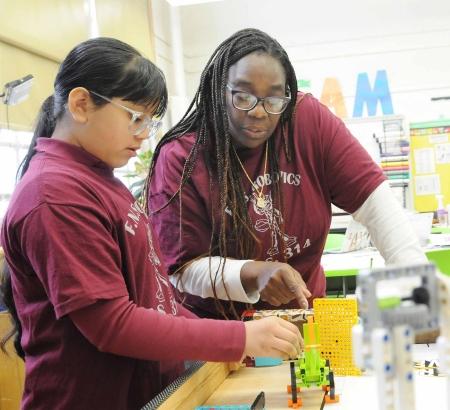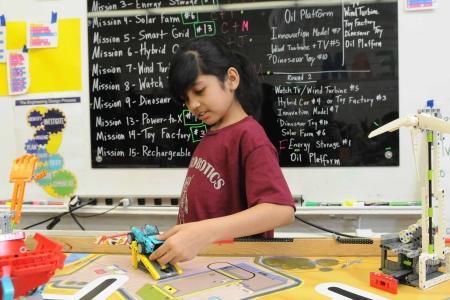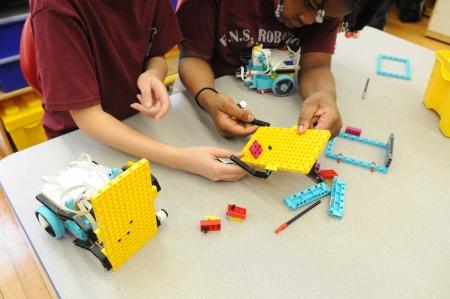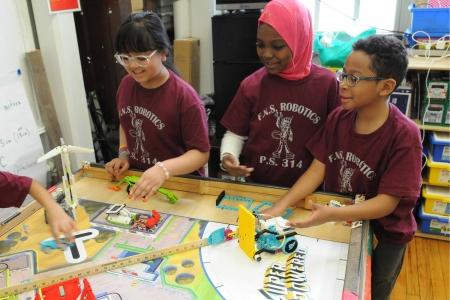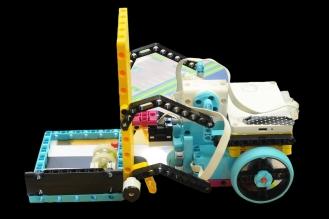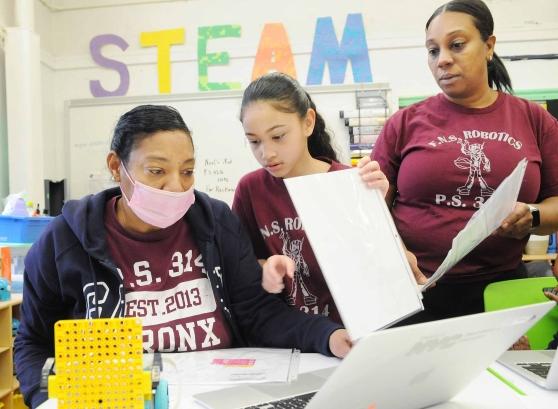
Paraprofessionals Judy Cruz (left) and Lanaya Bellamy consult with a student to remotely code the robot’s movements via a Bluetooth connection from a laptop.
It all started with two special education students and their one-on-one paraprofessionals, Lanaya Bellamy and Judy Cruz.
The paras noticed that the two students at Fairmont Neighborhood Elementary School in the Bronx felt disconnected from their coursework and their peers. But when they started building with LEGO bricks, they “lit up,” said Chapter Leader Dana Kirton, who was the classroom teacher for one of the students.
With Kirton’s support, Bellamy and Cruz approached the principal and suggested their students be allowed to build with LEGO bricks during lunch.
The change in them was striking.
“We’d been pushing to bring this student into our world,” said Cruz of one of the two students, “but when he started building, we came into his world.”
As more students noticed what had become a lunchtime LEGO club, the initiative rapidly grew. Nine years later, Fairmont has a LEGO League club for 3rd- to 5th-graders, a lunchtime robotics club for the same grades, a robotics junior club for 2nd- to 3rd-graders, a dedicated room for STEM (science, technology, engineering and math) and a My Sister’s Keeper club, which is modeled after other female empowerment programs but with a STEM focus. All three members who spearheaded the program have been honored with career and technical education awards from the UFT for promoting STEM skills in the early grades.
This year, the LEGO League club competed in the statewide finals of the FIRST LEGO League robotics competition with a clean energy-themed project. Their “Poop is Power” project included a machine that converts dog waste to energy. The team also built three robots and the necessary attachments with LEGO bricks to complete various challenges, including moving LEGO props across a table. After the students finished building, they wrote code to program the robots to complete their missions.
Fairmont students get the chance to start working with robotics as early as the 2nd grade, before they’re old enough for LEGO League. In the robotics junior club, the younger students use Dash and Dot robots programmed on tablets to learn the principles of engineering and coding. One of those students, a 3rd-grade English language learner, struggled to recall rotation measurements as he worked to rotate his robot Dash 180 degrees. Kirton slowly coached him through the process, prompting him to stand up and turn in a circle, until he had his “eureka” moment.
“I feel so confident now,” he exclaimed.
Kirton said elementary education is all about “building blocks,” and it’s as important to “expose children to the world” as it is to teach them how to “add numbers, think concretely and ask questions.”
“Science and technology are everywhere,” she said. “Why not start early and build on it?”
Bellamy emphasized the versatility of the skills that students develop through hands-on STEM activities. “They’re coding, building and crafting,” she said, “doing math, understanding directions, and doing art and design.”
The students develop problem-solving skills, too, Cruz noted. “Our approach is to tell them to figure it out and come to us if they get stuck,” she said. “Most of the time, they figure it out.”
Kirton called the school’s Fairmont neighborhood, to the east of Crotona Park, a “high-needs community, financially and educationally.” She cited access to technology during the pandemic and language barriers at home as some of the challenges her students face.
“In spite of these barriers,” she said, “our children thrive.”
The students’ projects are often inspired and supported by the community. The LEGO League’s Poop is Power project, for example, drew its inspiration from a local housing development that plans to derive its electricity from human waste. Kirton brought in an acquaintance who works for the housing project to mentor the students and explain the principles of the technology.
The idea to use dog waste came from the students. Kirton said one of them told her, “We could use this to get the dog poop off the street!”
The teacher and two paras all said they’re surprised that these STEM projects have become their passion since none of them was especially inclined toward technology when they were children. But the joy their students experience doing this hands-on work has been contagious.
“It’s the look on their faces when they find out they have robotics today. They get so excited,” said Cruz.
“They have fun,” she said, “and they learn so much.”
